We'll be posting anything and everything here worth mentioning around the club. Click any category below:

Golf Instruction Available Year Round
Avoid the winter doldrums and get your form ready for spring. Riley has is indoor teaching studio ready for winter golf instruction. GOLF LESSON PACKAGES

An Easy Tip to Improve Your Game
December 2023
The weather is cold, and the warm golf season is but a memory. Whether you are aware of it or not, your golf grips have taken a beating over the season. Wear and tear from the countless fairways and greens you’ve hit, dirt, heat, and oil from your hands all contribute to making those grips slick. Since this happens slowly over the season, it’s hard to notice. Just the tiniest slip at impact can cause your ball to miss the target by 10+ yards!
A common guideline is to re-grip your clubs once a year or every 40 rounds. Once a grip loses its traction, you are likely to start gripping your club tighter which can cause a whole host of problems in your swing. The traction that a fresh, new grip gives you is the ability to not fear the club slipping out of your hands. This relaxed state of gripping your club promotes the proper swing mechanics needed to hit the next fairway coming your way.
One other thing to be aware of as you think about new grips is sizing. Based on the size of your hand you may need a different grip than you are currently using. Our assistant professional Riley is available to help you find the grip that fits you.
A new set of grips is an easy and inexpensive way to bring a noticeable improvement to your game!
Contact Assistant Professional Riley Wilcoxon... Call or Text (937) 738-8844
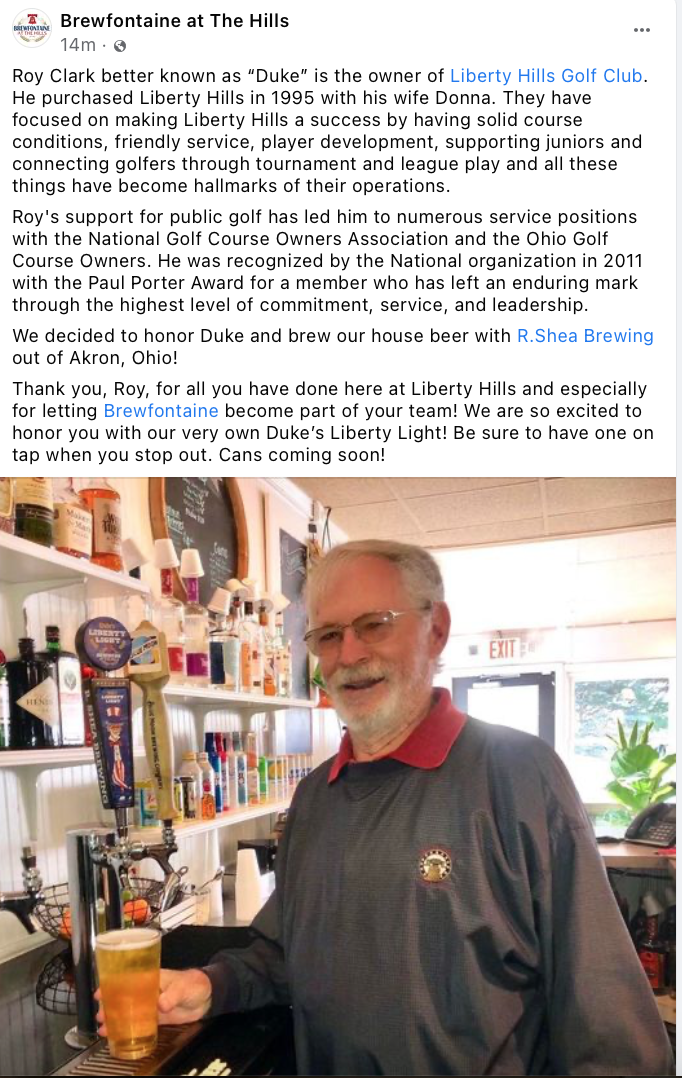
Enjoy a Duke, Exclusively at Liberty Hills
Memories of a Bygone Era
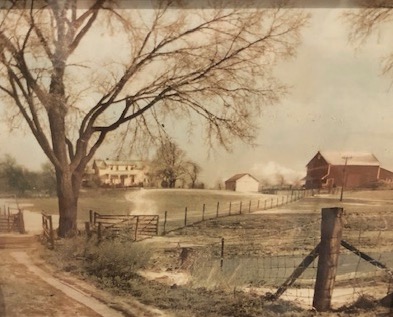
Pictured is the farm that formerly occupied the current back nine at Liberty Hills (the north side of Township Road 190 West.) Followed below by the land as the layout of the back nine developed in the early 1990's.
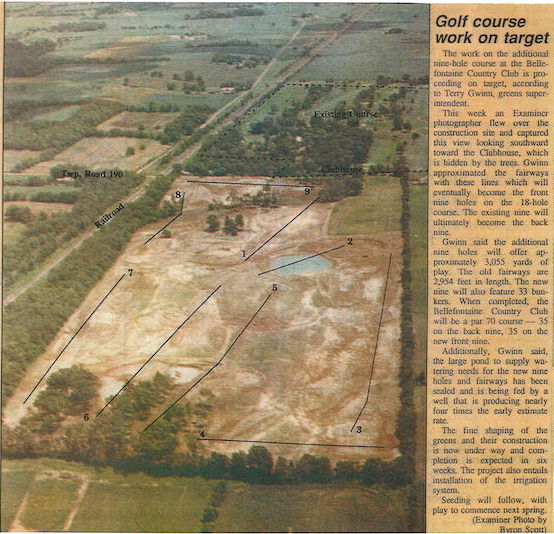
Many thanks to Logan County resident Marjorie Bixler for sharing her memories of the original farm:
"My mother’s maiden name was Sowers. Her parent’s names were Fred and Florence. She wasn’t born on the farm so they moved there sometime after 1915. She went to first grade from that farm so they must have moved there around 1920 or so. Grandpa used horses to farm until he bought a little Ford tractor. He also raised sheep. There was a livestock grate in the ground that rattled when you drove over it. That kept the sheep in the pasture in front of the house. Grandpa sold some of those sheep to get the money to send my mother to college during the depression.
We always enjoyed being neighbors to the Country Club. My mother collected errant golf balls to sell back to golfers. We always enjoyed the 4th of July fireworks from the front porch. Watermelon never tasted so good.
We also always enjoyed playing in the creek. Mom said when she was a girl , the creek was deep enough for her to learn to swim. We grandkids always enjoyed wading and screaming when we encountered a crawdad. We built little dams and splashed away many happy hours.
Grandpa did not tell any of the family that he was considering selling the farm. He felt it was time for he and grandma to move to a little house in Bellefontaine."
MORE MEMORIES...
Dr. Harry Graber, of West Liberty, recalls fondly:
"I had the privilege of having three "holes in one" on hole #9 (one from the back tee and 2 from the white tee).
Fortunately, two important persons were in the group, a preacher and an attorney."
Mark Carter, of Bellefontaine remembers:
"I remember when I was 12 years old in 1970, the Country Club actually used real caddies. I was one of them. But because I was so small, I was never chosen to carry any players clubs. So the next year at the age of 13, I was hired by the club to be a part of the grounds crew. I mowed fairways (not the greens), and actually dug out the sandtrap making it twice the size at the time on hole #7 par 3, and filled it in with sand. The cooks in the kitchen were awesome. They always made me butterscotch pies and the chef made great steak sandwiches."
We'd love to hear your memories! Please share HERE.
A History of Bellefontaine Country Club by Dick Weeks

Written by Dick Weeks of Bellefontaine
Former caddy, long time BCC Member & Liberty Hills starter
In the 1940’s the club house at the Bellefontaine Country Club was at the present site. The interior structure was different, however, as there were only two rooms- one was the kitchen and the other was a combination dining room and lounge. The cook was a lady named, Ethyl Scott. Dinner was served to the men on Wednesday evening. Wednesday was Stag Day and Ethyl was the only lady allowed on the premises except those who were there for entertainment purposes.
A brunch was served to the ladies on Thursday as it was Ladies’ Day and no men were allowed until 3:00 pm. Most of the ladies played either golf, bridge or slot machines before and after brunch. Dinner and dance was the normal occasion on Saturday nights. Brunch was served on Sunday after church and though wives and families came for the brunch, only men were allowed on the golf course until 3:00 pm. Because there was no air conditioning, the windows were always open. When Ethyl was in the kitchen, the aroma would permeate the entire golf course. Oh yes, Ethyl would always see that the caddies were able to enjoy her delicious sweet rolls.
The basement housed a very small locker and shower room for the ladies, a furnace room and a large locker and shower room for the men. The showers were located along the north wall of the basement. A part of the locker room was used for a poker table and for two large horse troughs for beer storage that was iced down each day but Monday when the course was closed to all play except caddies. There was shoe shine stand beside the entrance where John Ratleff shined shoes.
The pro shop/caddy shop was in the small old building west of the clubhouse, presently used for storage and workshop. The building had a rear entrance into a small room where the caddies would sign in, eat lunch and on rainy days, play cards. The rest of the shop contained room for club repair and storage. Nearly all members paid an annual storage fee to the pro. Their clubs were stored and cleaned each time they played and any repairs were made as needed, for an additional charge. There was also a dozen or so slot machines that sat along the north and south walls of the pro shop. They were encased in big steel cases that could be locked when the building was unattended.
Retail sales were limited to balls and occasional clubs. The most popular clubs were Robert T. Jones Jr. Signature made by Spalding, and MacGregor woods. The sets consisted of the Driver (1), Brassie (2), and Spoon (3 or 4). A Cleek (5) was also available. Iron sets were normally 2 through 9 with an occasional 1 iron or wedge. The most popular putter was a Tommy Armor Signature. The ball of the times was made by U.S. Royal. It had liquid center and was branded 1-star (*), 2-star (**), 3-star (***) and 4-star (****) with the 4-star being the best. Also available were the Acushnet, Pinnacle, MacGregor Tourney and Spalding Dot. Half finger golf gloves were also available in the pro shop and shoes could be ordered by catalog.
The grounds of the club consisted of a nine-hole golf course and tennis courts. The tennis courts were located in the woods north of the parking lot. The grounds were cared for by Guy Moots, Orrie Wilson and Junior Herres. The equipment consisted of a green’s mower (power driven reel), a tee and fringe mower (manual push reel type) and a Ford tractor which pulled a set of five gang mowers. Due to lack of manpower and to make balls easier to see, the entire course was mowed at fairway level where it was accessible by tractor. I don’t recall how often the greens were mowed, or the tees and fringes, but I do recall that each of task took nearly half the day to complete.
Weed control was non-existent and in late May and early June when dandelions were in seed, balls were very hard to locate. One year the weeds on the greens got so bad, the club hired migrant Mexican workers to come in and dig the weeds. They would come by railroad on flat cars and the trains would drop them off in the morning and pick them up in the evening. The greens were the only part the course that got watered, so usually from mid-July until the club closed on Labor Day, everything was dried up and burnt out except the greens, the woods, and the creek. With no fairways to mow, Guy and Orrie and Junior would get their scythes and their sickles sharpened and clean out the woods and creek beds. The fence line on hole #3 and out of bounds on #8 to the railroad tracks were kept clean periodically. The area around the club house and pro shop were mowed and trimmed by the pro or caddy master.
In the early 1940’s, caddies received 35 cents for 9 holes carrying a single bag and 30 cents per bag for carrying two bags for 9 holes, 65 cents for an 18-hole single and 60 cents per bag for 18 holes double. In 1944 or 1945 the club offered the caddies a 10 cent per bag raise. We had asked for 50 cents per bag across the board. When they refused, we went on a ‘sit down’ strike. After carrying their own bags (which were mostly leather with a 2-3-inch-wide strap) for a couple of rounds, they decided that our prices were not unreasonable.
At about this time Karl and Madeline Stump moved to Logan County from Florida. Both were good competitive golfers. Karl was a bit of an extrovert who dressed rather nattily with his flowered shirts and straw hats. He always lit his victory cigar on #1 tee and so intimidated some of his opponents. He had a huge heavy leather golf bag with all of the trimmings, including one of the largest golf umbrellas I have ever seen. I don’t recall any other golf umbrellas around at the time. He introduced a new game to the home boys- a $5 or $10 Nassau game. Although most of them could afford it, just the thought wore on their nerves until they got accustomed to it. Karl also paid his caddy very well, especially if he was a good caddy.
The original 9 holes consisted of three Par 3’s (5-7-9), three Par 4’s (1-2-4) and 3 Par 5’s (3-6-8) for Par 36. For an 18-hole score the nine holes were repeated. In the early 1940’s, “Red” Taylor shot a 7-under par 29 for the course record for nine holes. I think that record still stands, and since the trees have changed, can never be broken for the original nine holes.
The golf season opened on Memorial Day and ended on Labor Day. There was play before and after, but this was the time the clubhouse and pro shop were open. The Club Championship was finalized on Labor Day. All flights played Match Play tournaments and “B” and “C” Flights were to be completed prior to Labor Day. On Labor Day, the two Flight “A” finalists played 36 holes Match Play to determine who was to be Club Champion.
Hole #1 was played by both men and women from what we now call the Black tees. It played as a Par 4 for both men and for women. Standing straight from the tee on top of the hill about twenty yards west of the woods was a huge oak tree. It was known as ‘The Caddy Tree’ as that is where the caddies stood to watch the shots. Because you were looking into the sun in the mornings, it was difficult to see balls as they were hit, but it gave good vision to see balls drop into the woods. Lots of tee shots were also knocked down by The Tree. Its demise came from being struck by lightning many times. Once past this tree, it was completely open in the rough between #1 and #2 fairways. There was a sand trap in the rough about 120 yards short of #1 green. Nearly straight across #1 fairway toward the woods was a huge walnut tree which collected many drives and knocked them back into the woods. That tree was removed by a Club President one year because his drives could no longer carry it.
Hole #2 was played by both men and women from the farthest west now Black tee. Par for both was 4. The only trouble short of the green was the woods down the right boundary until you reached the green. The area to the right of the green down in the hollow was very swampy and with knee deep grass and weeds did not allow you to go into that area. Balls in there were nearly always declared lost. Up on top beside the green were two grass bunkers where they normally allowed the grass to grow a little longer to stop balls that may have rolled into the swampy area.
Hole #3 was played by both men and women from what is now the western most Black tees. It was a Par 5 for both. The creek bed was about twenty yards closer as it snaked back north from the bridge at #5. In front of the tree that stood at the edge of the creek in the left rough, the creek spanned about 15 feet and was quite deep. Water was pumped from it to water the greens. In the center of the fairway next to the bridge crossing the creek stood a large cottonwood tree. Nels Nelson was a ‘straight down the middle’ golfer but not a real long ball striker. He became so frustrated with his ball hitting it on tee shot that he had it cut down when he was Club President. The Out of Bounds fence on the west side was kept fairly clean and the fence was well maintained. Wooden steps were built at three separate locations so that the caddies could climb over the fence to retrieve golf balls. The only trees were the large trees that now stand in the rough between #3 and #4 fairways and the tree that sits by the sand trap left of the green.
Hole #4 was played by both men and women from what is now the Black tees and was a Par 4 for both. There were no trees on the hole except the old large trees in the roughs between holes #3 and #4, and #4 and #6. The sand trap behind the #5 tee was merely a grass bunker but a large tree with low hanging branches stood between it and #5 tee and protected the green from the left. There was a small sand trap directly to the east of #4 green. The trap was shallow and as the fringes were mowed, a putter could easily be used. With no watered fairways and no obstructions in front, the green was easily accessible from the tee with a 4 or 5 wood. When Ron Line became the Club Professional, he extended the green side trap around in front of the green, and made the sand bunker left of the green. He also cut facings in front of the traps so that you could not putt it out. Since hardly anyone carried a sand wedge at that time, he sold lots of them. There were so many complaints about the front trap that he filled it in about ten feet in front. In another effort to protect the front of the green, when Charlie Townsend was Club President, he planted a white poplar tree on top of the hill as you approach the green. About three years later, a bad ice storm split it and broke half of it off. It was then replaced by the present tree at the right front of the green. During rainstorms, water collected in the bottom area of the fairway and would encompass the entire fairway and much of the rough between #3 and #4 and became known as Thompson’s Pond. Ed Thompson was a championship golfer and one of the longest hitters, but when the water collected, he was apt to miss hit the ball and wind up in the water and so wet or dry #4 fairway became known by this handle.
Hole #5 was played by the men from the current Black tee and by the women from the current Red tee as a Par 3 by both. The creek then was a bit wider and particularly in front of the trees at the right edge of the fairway. There was a large pool which was quite deep and was used to draw water for the greens much like the one on #3. The green was unprotected from trees or shrubs except the Spirea bushes right of the green. Again, the sand traps were small and you could easily putt or chip to the green.
Hole #6 was played by the men from the current White tees and by the women from a tee sitting at the bottom of the hill almost directly between the men’s tee and the green. It played as a Par 5 for both. To the right of the cart path across the bridge between the creek and the crest of the hill there were several surface springs that extended around to the present pond. It was always too wet for mowing and so was very mushy. A huge weeping willow stood about the site of the Artesian Well beside what is now the pond. On top of the hill between #6 and #8 fairways stood the equipment barn where the mowers and tractor were stored and it was surrounded by apple trees. One large tree stood across the fairway from the barn at the top of the hill, from where it was open to the green and at the time was clear of sand traps. Between #6 green and #4 tee was a well with a hand pump. A tin cup hung from a wire for all to drink from. Though I don’t recall anyone getting sick from drinking from it, I understand the county Health Department made the club remove it. Reportedly, it was not because of bad water, but because birds perched on top of the pump and their droppings fell into the mouth of the pump where the water came out. Although the bridge at the creek bottom was also wide enough to cross with the equipment, the bridge on #6 was the one generally used. All other bridges were foot bridges. There was a very large patch of mint around the bridge and was quite often picked to adorn the dinner plates at the club house. There was also a small spring that emptied into the creek to the right of the bridge that men would drink from by cupping their hands to catch the water.
Hole #7 was played by both men and women from the men’s tee and was a Par 3 for both. The hole was trouble-free with only small sand traps on each side toward the front and were formed so that you could putt from them. Out of Bounds was across the road. During the 1970’s, the greenside bunkers were extended both toward the front and back. At the same time, a sand bunker was placed about 25 yards in front of the green running north and south the length of the green. The idea was to keep the men from running the ball to the green, but it actually came to be the landing area for most of the women.
Hole #8 was played by both men and women from what is now the Black tees and was Par 5 for both. Out of Bounds on the right was determined by a row of telephone poles which ran the entire length of the hole. On top of the hill next to the equipment barn were the clump of trees about 100 yards short of the green and blocked out anything left of the fairway. The only other nemesis was the shrill warning signals of the trains as they approached the crossings. During the 1940’s, rail travel and shipping were very prevalent so lots of trains ran past the golf course. The sand trap left of the green was placed there in the 1970’s.
Hole #9 was played by the men from what is now the Black tees and by the women from today’s White tees. The current bridge was a footbridge. About 10 yards to the left was another bridge where you were able to walk down the bank and cross the creek in the bottom where most of the tee shots came to rest. As I recall, this bridge was wide enough cross with the greens mower. Out of Bounds was defined as any ball that came to rest in or across the creek bed running parallel to the fairway. The green was larger than now and expanded toward the club house quite a few feet. The creek was also where the caddies had a swimming hole that was used for skinny dipping.
Country Club's Beginnings
from the Bellefontaine Examiner, 1979
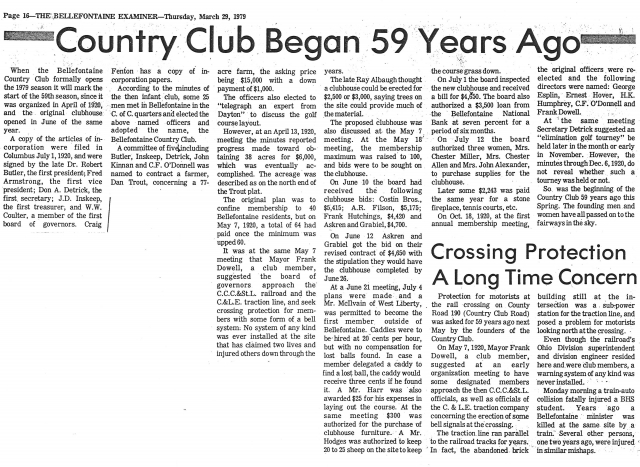
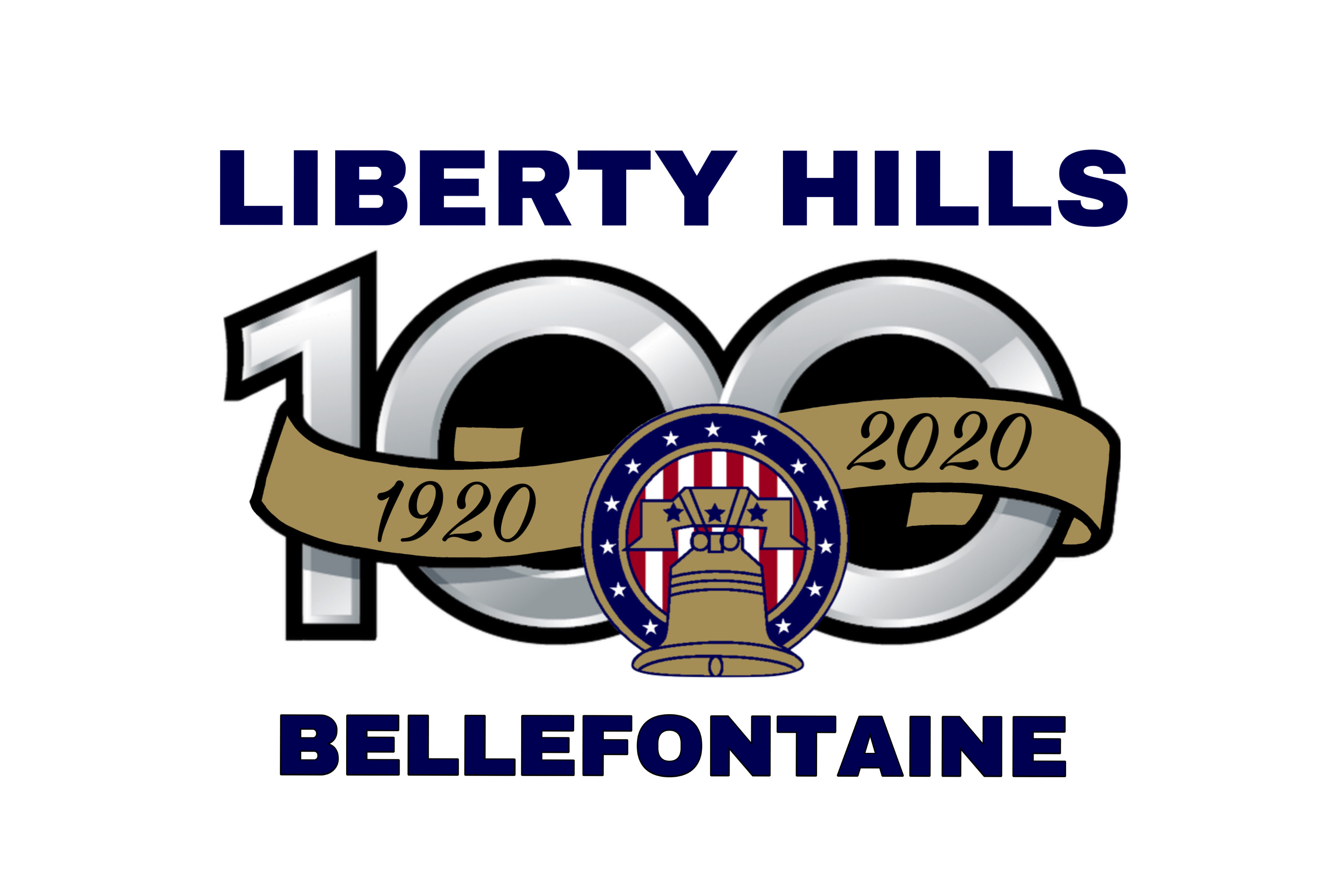
Celebrating 100 Years of Golf!
According to a newspaper article from July 19, 1907, "The first steps toward the organization of a country club for the pleasure loving people of Bellefontaine were taken at a meeting held in the offices of Dr. J.P. Harbert which was attended by about 30 enthusiasts who were pioneering the movement."
"It is the purpose of the club to buy or lease a country place, on the line of the traction railway either south or north of town, and there a establish a modern club equipped with golf links, tennis courts, and where meals and lodgings can be had by the members and their families."
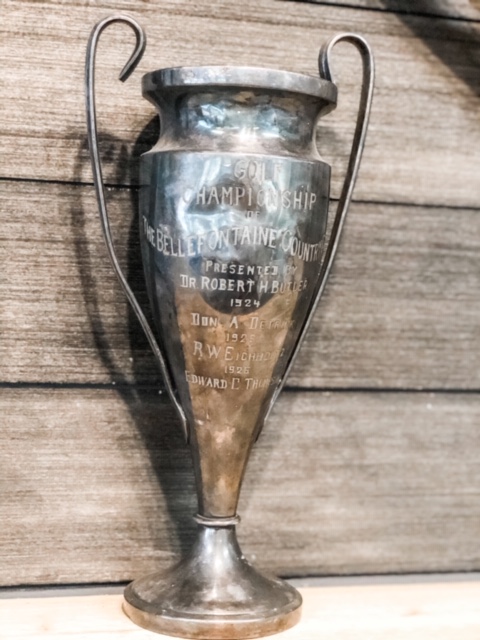
This fabulous old trophy dates back to 1924 at the club. (Thanks to Bud Eichholtz for sharing it with us. It features his father's name.) All former Club Champions (flights, net, etc) will be invited back to participate in our Homecoming Weekend and Tournament of Champions July 11-12, 2020. (Cancelled for 2020 due to CoronaVirus. Hoping to reschedule in 2021.)
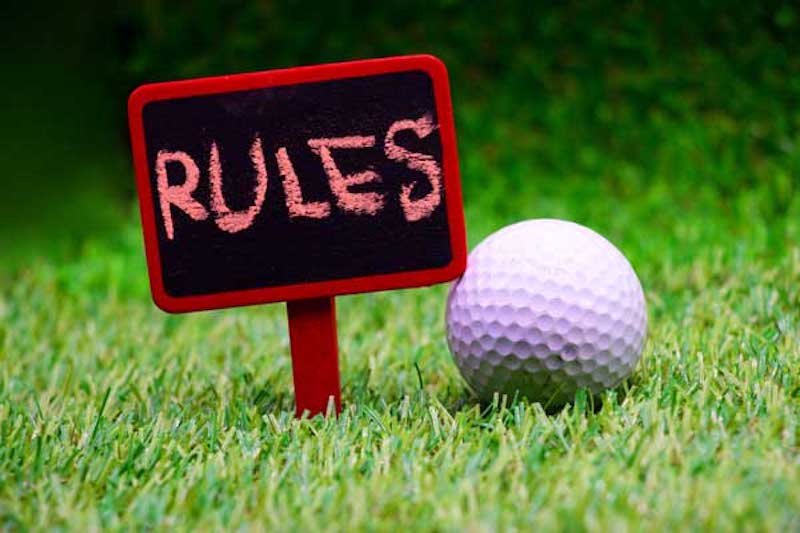
New Golf Rules 2019: What You Need to Know
In the most sweeping revision in more than 60 years, officials from the USGA and R&A, golf's governing bodies, have reorganized the rules making them easier to understand and apply. These useful changes can help save you strokes and will benefit everyday golfers.
Here's a quick look at the new rules that can have the biggest impact on your game:

Problems Slicing? Try this Slice-Proof Grip
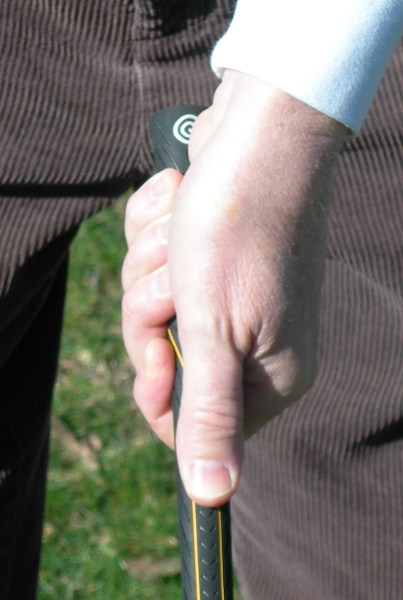 #1- WRONG- With left thumb straight down shaft, this is a slice grip. |
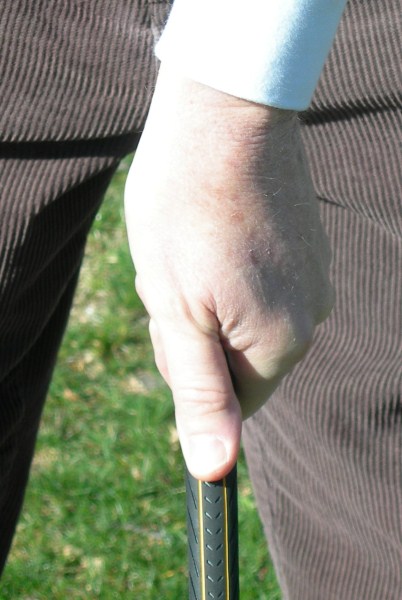 #2- CORRECT- Left thumb correctly angled toward right shoulder. |
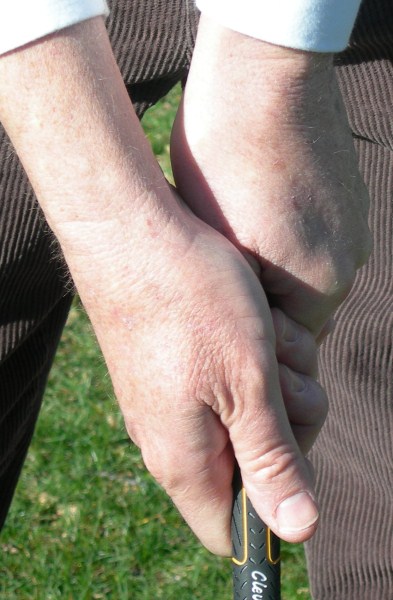 #3- Right palm fits naturally over left thumb. |

Chipping: The One-Fourth Rule
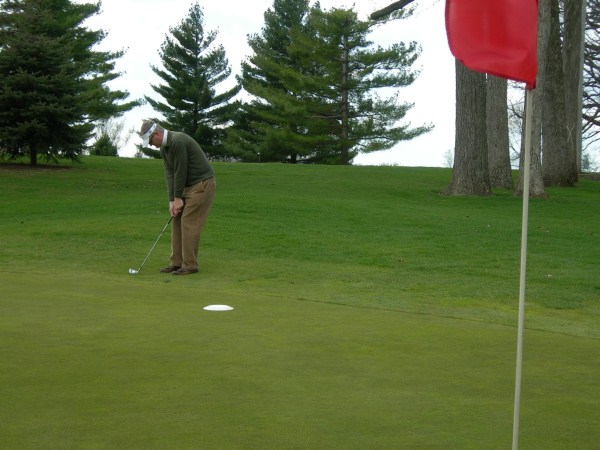 |
 |
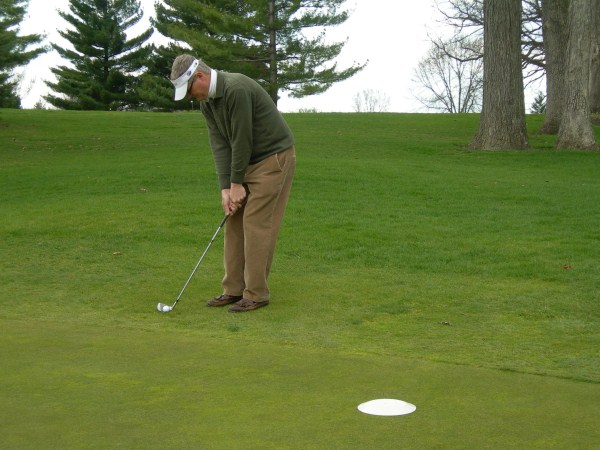 |
|
Focus on a spot for your ball to |
The landing spot should be one |
Once you have determined where |
Keys to Success:
1. Use this shot only when your landing spot is on the fringe or the green.
2. The One-Fourth Rule assumes a flat surface. Adjust for slopes accordingly.
3. This ratio applies specifically to the 9-iron chip shot.

One-Thousand-One Putting Tip
Regardless of the length of the putt, the rhythm and duration of the stroke should remain the same. Try saying the phrase: "One-thousand-one" to yourself as you putt. Saying the words in a natural cadence should take a little longer than one second. Applying this rhythm to every length of putt will help your speed control.
 |
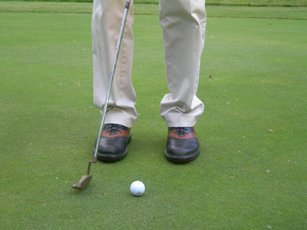 |
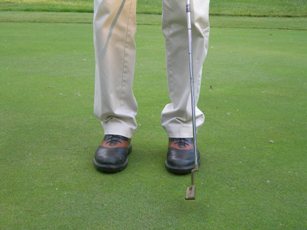 |
|
Here's how a short putt looks: Begin |
On the back swing say: |
On the through swing say: |

Simplify Greenside Bunker Shots
When hitting a shot from a greenside bunker, a very effective swing thought is to hit some sand out onto the green. If you're not getting enough sand, square the club face and swing at a steeper angle. If you're getting too much sand, open the club face and swing at a more shallow angle.
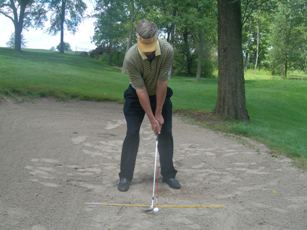 |
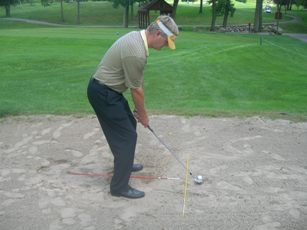 |
|
At address: Ball position just inside left heel |
Club face is open so it slides under the ball |
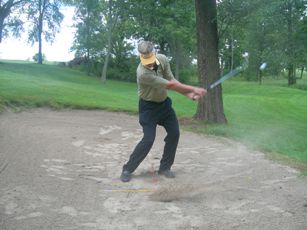 |
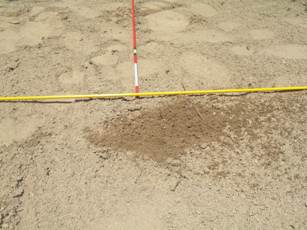 |
|
Swing with enough force as if to hit a |
Long shallow divot... think bacon strips not |









